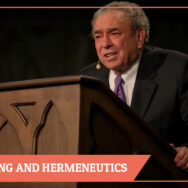Head Covering and the Holy Kiss

The holy kiss is commanded in the New Testament five times by two different authors. 1) See Rom 16:16, 1 Cor 16:20, 2 Cor. 13:12, 1 Thess. 5:26, 1 Pet 5:14 This is the greeting we’re told to give one another in Christ. Much like head covering, the holy kiss is a rare sight in the North American church since it’s culturally out of step. We are accustomed to greeting with handshakes and hugs instead. Some object that this is inconsistent treatment of two New Testament practices. How can we insist on head covering yet leave behind the kiss? After all, both are commanded in the New Testament. In this article we’d like to address this objection.
The Difference
While it is true that both practices are commanded in the New Testament, there is a significant difference between them. In his book “Knowing Scripture” R.C. Sproul teaches us when it’s appropriate to fill in the gaps with our cultural knowledge. He says:
“If Paul merely told women in Corinth to cover their heads and gave no rationale for such instruction, we would be strongly inclined to supply it via our cultural knowledge. In this case, however, Paul provides a rationale that is based on an appeal to creation, not to the custom of Corinthian harlots.” 2) Quote taken from http://www.headcoveringmovement.com/articles/head-covering-and-hermeneutics-an-excerpt-from-knowing-scripture-by-r-c-sproul
Sproul tells us that if something in Scripture has no explanation then cultural knowledge can aid us in understanding why it is mentioned. What he warns against is doing this when the author explains the practice himself. This brings us to the major difference between head covering and the holy kiss. When it comes to head covering, the apostle Paul explains the practice in depth. He appeals to the creation order, nature’s witness and angels, all which transcend culture. In contrast, the holy kiss is never explained, never defended, and has no theological underpinning. Now this doesn’t mean one of theses practices is valid today and the other is not, that’s not the question we’re trying to answer right now. What I am saying is, it isn’t inconsistent to treat them differently because only one of these practices is explained to us with a transcultural foundation. So headcovering can’t be cultural whereas the holy kiss may or may not.
To help illustrate the difference between them further, let’s apply the same wording found in the head covering passage to the holy kiss command in 1 Thess 5:26 (ESV).
- For this reason I want you to greet God’s people with a holy kiss, because of the angels. (1 Cor 11:10b)
- Every man or woman who does not greet God’s people with a holy kiss brings dishonors to themselves. (1 Cor 11:4-5)
- If anyone is inclined to be contentious about greeting God’s people with a holy kiss, we have no other practice, nor do the churches of God (1 Cor 11:16)
- Since it is disgraceful for a woman to refuse to greet God’s people with a holy kiss, let her do it. (1 Cor 11:6)
- [Appeal to the creation order], that is why a woman ought to greet God’s people with a holy kiss (1 Cor 11:7-10a)
If this type of explanation, defense, and theological underpinning were applied to this form of greeting, we’d have no choice but to insist on it being practiced today. I’d probably even start a holy kiss movement 🙂 But since that type of language is never used, we cannot act like it’s the same as head covering. Now that we’ve established that it isn’t inconsistent to treat them differently, let me give you my take on if we should greet one another with a kiss today.
Should We Greet With a Kiss?

There have been a few times in my life when I’ve greeted brothers with a kiss. It was usually after a prolonged period of not seeing them. I’ve also been kissed a few times myself by other brothers. These experiences in my own life have been rare, but memorable. As I reminisce on these experiences the thought that floods my mind is love. Their love and care for me or mine for them. It was a sign that they were more to me than an acquaintance or a friend, they were my brother, whom I loved. When I think about what the Bible says about the church, this matches perfectly. The church is a family and we’re to treat each other accordingly. We are to “treat younger men as brothers, older women as mothers, and younger women as sisters, with absolute purity.” (1 Tim 5:1-2) This includes practical expressions of love and care like bearing one another’s burdens (Gal 6:2) and sharing our possessions with those that have need (Acts 2:45). While we are to show love to everyone, Paul teaches us that it’s the family of God that comes first. He says, “let us do good to everyone, and especially to those who are of the household of faith”. (Gal 6:10) If we are a new family in God, it makes sense that we should greet one another like we’re family. So while it is possible that the kiss was a culturally appropriate first century greeting 3) The evidence seems to point against the culture viewpoint. “Traditionally in the Graeco-Roman world, an intimate practice such as kissing would have been reserved only for close family members…” – Ehorn, S. M. (2012, 2013, 2014, 2015). Kiss. In J. D. Barry, D. Bomar, D. R. Brown, R. Klippenstein, D. Mangum, C. Sinclair Wolcott, … W. Widder (Eds.), The Lexham Bible Dictionary. Bellingham, WA: Lexham Press. , it is also possible that the Apostles may have been setting forth a Christian greeting. 4) ”In the generations following the apostolic era the kiss of peace came to occupy an established place in liturgical worship. In the latter part of the 2nd century Justin Martyr spoke of the exchange of kisses throughout the congregation following the conclusion of prayer. Eventually the church placed the ceremony immediately prior to Holy Communion.” – Elwell, W. A., & Beitzel, B. J. (1988). In Baker encyclopedia of the Bible (p. 1291). Grand Rapids, MI: Baker Book House. They may have been saying “you are brothers and sisters, so greet one another like the family that you are.”
Megan Hill (Author, Praying Together), writing for the Gospel Coalition says on this topic:
“We might be tempted to think of the holy kiss as a practice for a particular first-century culture, too fraught with issues for our day. But this imperative covers the wide diversity of the New Testament church. Paul commands it, and Peter commands it, too. It is required of the Jewish-background diaspora recipients of Peter’s epistle, and also of the Roman and Thessalonian churches—bodies largely composed of Gentile converts. Twice, the holy kiss is commanded for the Corinthian church, a church so beleaguered by sexual impropriety that you’d think the apostle Paul would ban touch altogether.”
So should we greet one another with a holy kiss? I think local churches would be healthier if they did. However, it is difficult to implement practically since it requires another’s consent. If a woman is convinced she needs to cover her head, she can just show up to church wearing a veil. But just imagine how difficult the head covering command would be if you had to place a veil on someone else’s head (when the majority are likely against it). That’s the problem with the holy kiss since it’s something you do to someone else. Many people are uncomfortable with this form of affection due to various reasons and would recoil if someone tried to greet them in this manner. So I think the only way this practice could be implemented in our “non-touch” culture is from the top-down 5) Meaning from the church leadership to the laity. , church by church. A pastor would have to preach through a text like 1 Thess 5:26 and exhort the congregation to implement it. Everyone needs to be on the same page for it to work and preaching is the only way for everyone to be unified at the same time. Until then (or if it never happens), I think we should try to at least fulfill the principle. I think at minimum brothers and sisters of the same gender 6) Scripture doesn’t specify if men and women kissed each other or if it was only between those of the same-sex. Since it’s not explained it would be fine to limit it in this way. Having said that the early church did not limit the kiss to those of the same gender. should greet one another with warm, physical affection. A wave or a handshake should not be the only way we greet one another. It just doesn’t communicate the same closeness there is among family. A hug or some other form of warm embrace is a step in the right direction to the Scriptural ideal.
Summary
Head covering and the holy kiss are similar in that they are both New Testament commands. Even though they share that similarity they are different in that head covering is defended and explained for fifteen consecutive verses whereas the holy kiss is never explained or defended. It is impossible to assign cultural reasons for head covering because the author’s own reasons are given, and they are non-cultural in nature (creation order, angels, etc.) but the same cannot be said about something without explanation like the holy kiss. This means that it is not inconsistent to hold to head covering but not the holy kiss. Having said that we personally see the benefits of greeting with an actual kiss as a way to demonstrate brotherly or sisterly love.
References
- The Head Covering Movement’s New Direction: A Call for Team Members - July 11, 2025
- Is Head Covering Related to Spiritual Gifts? A Response to Barry York - July 5, 2023
- A Husband’s Authority is Limited (He is Not Pastor or King) - November 14, 2022



